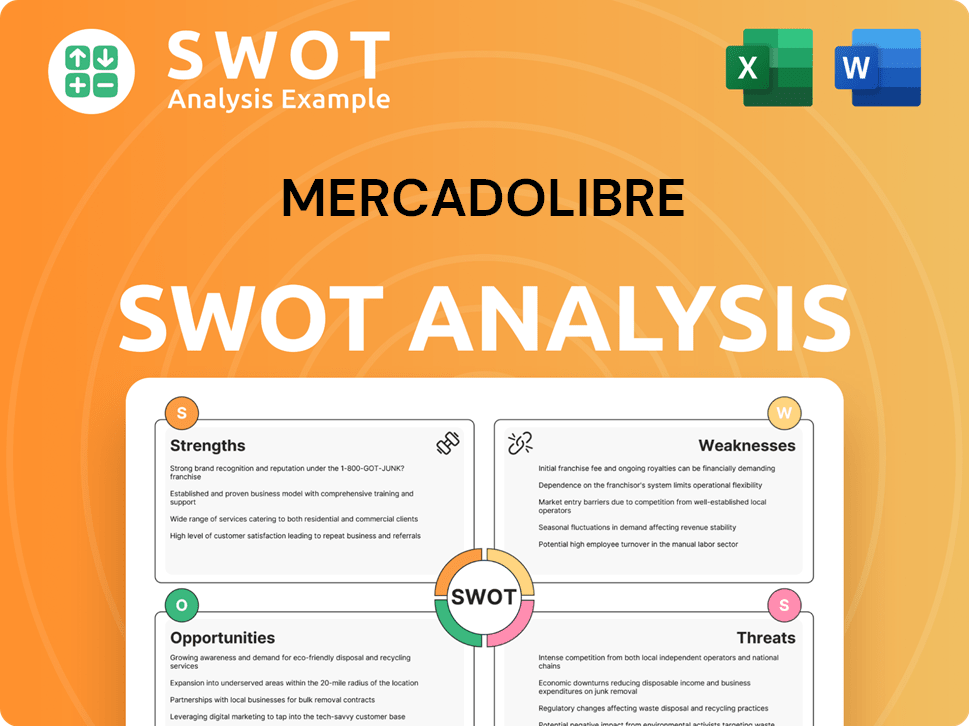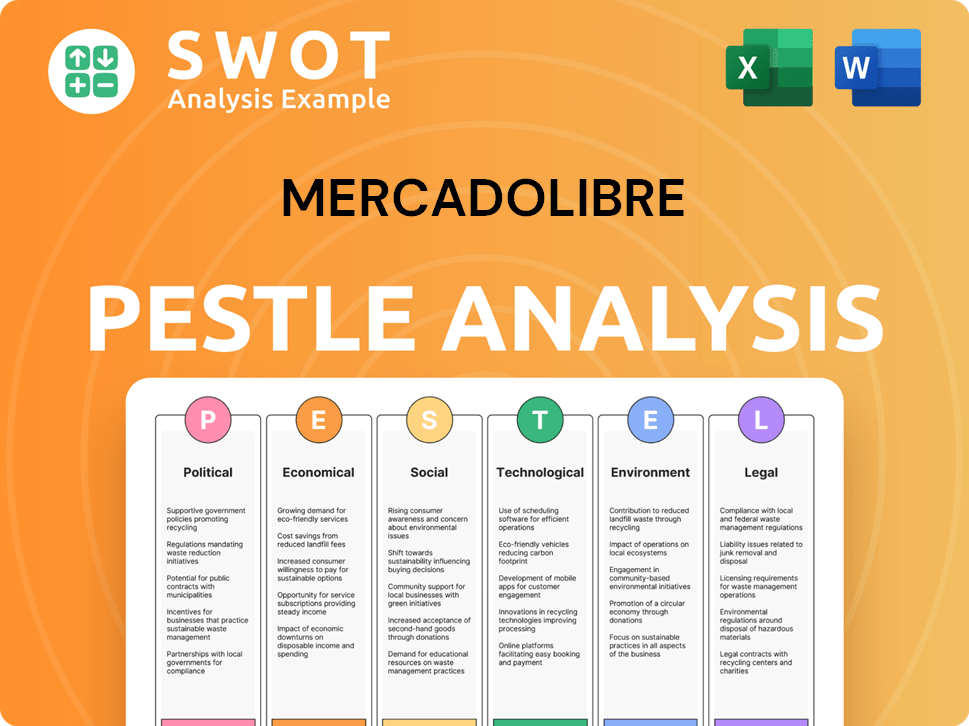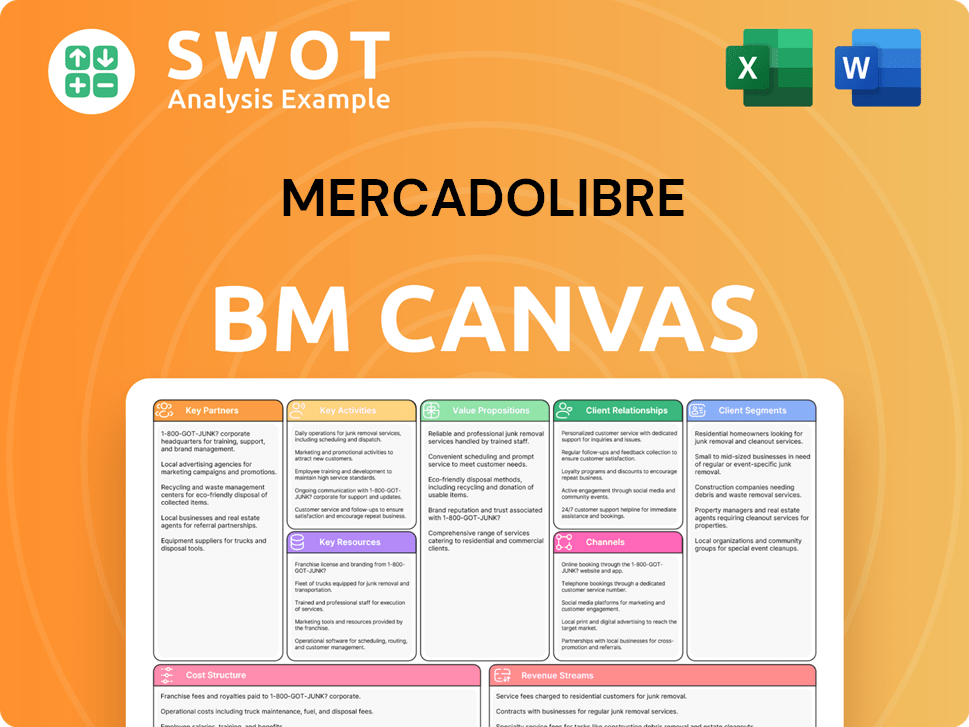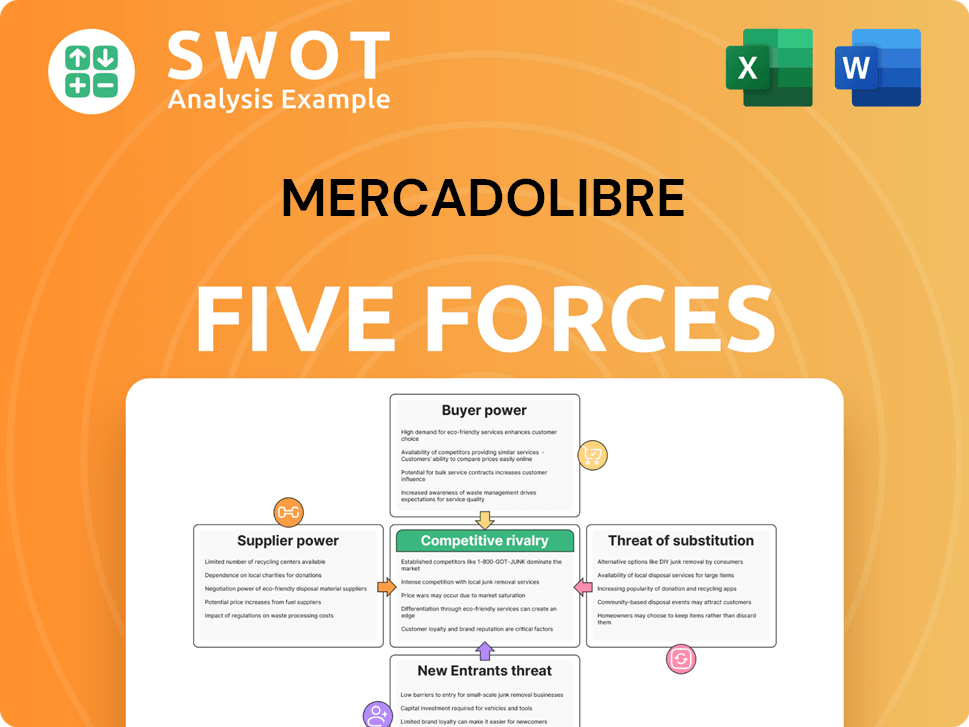MercadoLibre Bundle
How Does MercadoLibre Thrive in Latin America?
As the 'Amazon of Latin America,' MercadoLibre company has revolutionized e-commerce and fintech across the region. With a market capitalization of approximately $100 billion and impressive revenue growth, this powerhouse is reshaping how business is done. Discover how this online marketplace has become a crucial player in the digital economy.

MercadoLibre's success stems from its integrated ecosystem, encompassing an e-commerce platform, payment solutions, and logistics. Operating in 18 countries, including key markets like Brazil and Mexico, the company's impact is undeniable. For investors and business strategists alike, understanding MercadoLibre SWOT Analysis is essential to grasp its competitive advantages, business model explained, and future potential in Latin America.
What Are the Key Operations Driving MercadoLibre’s Success?
The core operations of the MercadoLibre company are centered on its fully automated online marketplace and its comprehensive fintech platform, Mercado Pago. This combination creates a powerful, self-reinforcing ecosystem that drives its business model. The company serves a diverse customer base, including individual sellers, small and medium-sized businesses (SMBs), and larger institutions, enabling them to engage in digital commerce.
As of Q3 2024, the e-commerce platform had 60.8 million unique marketplace buyers, marking a 21% year-over-year increase. The platform offers a wide array of products, with a focus on categories popular in Latin America, such as electronics, automotive parts, and home goods. This strategic focus helps MercadoLibre capture the preferences of its target market effectively.
The company's value proposition is built on a robust logistics network, Mercado Envios, and its integrated fintech services. These elements work together to provide a seamless and efficient experience for both buyers and sellers. By continuously investing in technology and infrastructure, MercadoLibre aims to enhance its services and expand its reach across Latin America and beyond.
The online marketplace allows sellers to list and sell a wide variety of products. The platform is designed to be user-friendly, with features like improved filters and category-specific options. This focus on user experience is a key component of How MercadoLibre works.
Mercado Pago provides a suite of financial services, including digital accounts, debit cards, and credit lines. It also offers payment processing for merchants. This integration of e-commerce and fintech creates a cohesive ecosystem.
Mercado Envios is a critical part of the value proposition, reducing delivery times. In 2024, 95.1% of shipments originated from its own logistics facilities. Over 71.8% of deliveries were completed within 48 hours.
The company opened 10 new fulfillment centers in 2024. It is expanding its free shipping offerings and aims to double its Brazilian fulfillment footprint by the end of 2025. A fulfillment center in Texas, USA, was opened in Q2 2024 to broaden product assortment for Mexican consumers.
MercadoLibre distinguishes itself by focusing on the Latin American market and empowering SMBs. It provides them with payment tools, platforms, and logistics networks, creating a competitive advantage. This approach is central to understanding the MercadoLibre business model explained.
- Strong presence in Latin America.
- Integrated e-commerce and fintech solutions.
- Focus on SMBs with tailored services.
- Continuous investment in logistics and technology.
MercadoLibre SWOT Analysis
- Complete SWOT Breakdown
- Fully Customizable
- Editable in Excel & Word
- Professional Formatting
- Investor-Ready Format

How Does MercadoLibre Make Money?
Understanding the revenue streams and monetization strategies of the MercadoLibre company is crucial for grasping its financial performance and growth potential. This analysis delves into the diverse methods through which MercadoLibre generates income, focusing on its e-commerce and fintech segments.
The company's ability to monetize its platform and financial services has driven significant revenue growth, particularly in Latin America. This chapter explores the key revenue streams, including commerce, fintech (Mercado Pago), and advertising, along with innovative monetization strategies that contribute to MercadoLibre's financial success. For a deeper understanding of the company's overall strategy, you can read about the Growth Strategy of MercadoLibre.
In 2024, MercadoLibre reported impressive financial results, demonstrating its strong market position and effective monetization strategies.
Commerce revenue is a primary driver, stemming from product sales and transaction fees on the e-commerce platform. In Q4 2024, this segment saw a 44% year-over-year increase, reaching $3.6 billion.
Fintech revenue, generated by payment processing and credit solutions, is another significant contributor. In Q4 2024, Mercado Pago's net revenue was $8.6 billion, up 24.8% year-over-year.
Advertising revenue is growing rapidly, with advertisers displaying product ads on the webpages. In Q4 2024, advertising revenue increased 41% year-over-year, reaching 2.1% of GMV.
Gross Merchandise Volume (GMV) on the commerce platform reached $14.5 billion in Q4 2024, an 8% year-over-year increase, with items sold increasing by 27%.
Total Payment Volume (TPV) reached $197 billion in 2024, up 34% year-over-year, while total payment transactions (TPN) topped 11.4 billion.
The credit portfolio reached $6.6 billion in Q4 2024, a 74% year-over-year increase, with credit cards being the largest contributor to growth. Mercado Pago's credit card portfolio surged 118% to $2.6 billion in Q4 2024.
The company employs several innovative strategies to boost revenue and customer engagement. These include platform fees, bundled services, and tiered pricing models. The relaunched Meli+ loyalty program, for example, offers incentives like free shipping and content streaming. Furthermore, the introduction of 'Meli Dólar,' a stablecoin pegged to the US dollar, enhances its digital asset offerings.
- Meli+ offers differentiated perks to consumers, including free shipping and content streaming benefits, incentivizing greater platform usage.
- 'Meli Dólar,' a stablecoin pegged to the US dollar, available in Brazil and Mexico, enhancing its digital asset offerings.
- Brazil remains the largest market, contributing 54.9% of total consolidated net revenues and financial income in 2024, followed by Mexico and Argentina.
MercadoLibre PESTLE Analysis
- Covers All 6 PESTLE Categories
- No Research Needed – Save Hours of Work
- Built by Experts, Trusted by Consultants
- Instant Download, Ready to Use
- 100% Editable, Fully Customizable

Which Strategic Decisions Have Shaped MercadoLibre’s Business Model?
The journey of the MercadoLibre company has been marked by significant milestones and strategic moves, solidifying its leadership in Latin America's e-commerce sector. A key early move was the integration of Mercado Pago, which by Q3 2024, accounted for 41% of total sales, establishing a strong foundation for its fintech operations. In 2024, the e-commerce platform achieved notable milestones, surpassing 100 million annual unique buyers on its marketplace and reaching 61 million fintech monthly active users for the first time.
The company's strategic investments in its logistics network, Mercado Envios, have provided a crucial competitive edge. In 2024, the company opened 10 new fulfillment centers and expanded its free shipping offerings. Strategic investments of US$4.6 billion in Brazil and US$2.5 billion in Mexico for 2024, followed by plans to invest US$3.4 billion in Mexico in 2025, enhance technology, logistics, and fintech operations. These investments have led to 49% of shipments in Q4 2024 being delivered within the same or next day, a 21% improvement from the previous year.
Operational challenges, such as economic volatility and currency fluctuations in Latin America, have been navigated through strategic investments and a focus on operational efficiency. For more details on the company's origins, you can check out this article: Brief History of MercadoLibre.
In 2024, the MercadoLibre company surpassed 100 million annual unique buyers. The company reached 61 million fintech monthly active users for the first time. The company has expanded its logistics network, Mercado Envios.
Early integration of Mercado Pago, which accounted for 41% of total sales by Q3 2024. Strategic investments of US$4.6 billion in Brazil and US$2.5 billion in Mexico in 2024. The company plans to invest US$3.4 billion in Mexico in 2025.
The company has a strong brand presence, operating in 18 countries. The integrated ecosystem of e-commerce, Mercado Pago, and logistics network is a significant advantage. Continuous investment in proprietary technologies allows for rapid scalability and world-class services.
Mercado Envios provides a crucial edge, with 95% of packages routed through its proprietary system in 2024, enabling efficient and cost-effective deliveries. The company expanded into credit products and digital banking, particularly in markets with low banking penetration like Mexico.
The MercadoLibre company's competitive advantages are multifaceted, including a strong market presence and an integrated ecosystem that is difficult for competitors to replicate. Continuous investment in technology and a robust logistics network further enhance its position.
- Established Market Presence and Brand Strength: Operates in 18 countries and holds a leading position in most markets.
- Integrated Ecosystem: The synergy between its e-commerce platform, Mercado Pago, and logistics network creates a powerful, difficult-to-replicate ecosystem.
- Technology Leadership: Continuous investment in proprietary technologies allows for rapid scalability and world-class services.
- Logistics Network: Mercado Envios provides a crucial edge, with 95% of packages routed through its proprietary system in 2024, enabling efficient and cost-effective deliveries.
- Financial Inclusion: Mercado Pago's expansion into credit products and digital banking, particularly in markets with low banking penetration, reinforces user loyalty.
MercadoLibre Business Model Canvas
- Complete 9-Block Business Model Canvas
- Effortlessly Communicate Your Business Strategy
- Investor-Ready BMC Format
- 100% Editable and Customizable
- Clear and Structured Layout

How Is MercadoLibre Positioning Itself for Continued Success?
The MercadoLibre company holds a commanding position in Latin America's e-commerce and fintech sectors. As the largest online commerce ecosystem based on unique visitors and processed orders, and a leading fintech platform, it has significantly outpaced competitors. In 2024, the company generated $50 billion in revenue, demonstrating its strong market presence.
Despite its dominance, MercadoLibre faces challenges. These include macroeconomic volatility, intensifying competition from global and regional players, regulatory hurdles, credit risk, and emerging technology risks. However, the company is actively pursuing strategic initiatives to sustain and expand its profitability.
MercadoLibre is the leading e-commerce platform in Latin America. It controls over 55% of the region's digital retail media market, significantly ahead of Amazon's 17.7%. Brazil, contributing 54.9% of total consolidated net revenues in 2024, remains its most important market.
The company faces risks from macroeconomic instability, including currency fluctuations and political uncertainty. Competition from Amazon and other regional players like Shopee and AliExpress is also a major concern. Regulatory scrutiny and credit risk associated with Mercado Pago's credit offerings pose additional challenges.
The company plans to expand its logistics network and technology infrastructure, especially in Brazil and Mexico. Mercado Pago aims to become the largest digital bank in Latin America. The e-commerce market in Latin America is projected to reach $232 billion by 2028, offering significant growth potential.
MercadoLibre is focusing on 'regionalizing' its logistics, building warehouses in smaller cities. It is also enhancing its digital account and credit card offerings through Mercado Pago. The company is actively exploring strategic acquisitions and partnerships to further its growth.
Understanding MercadoLibre's position in the competitive landscape is crucial for investors and businesses. The company must navigate economic volatility while competing with global giants. For those considering investment or partnerships, it's important to consider the company's strategic initiatives and market dynamics. You can find more information about its competitors in the Competitors Landscape of MercadoLibre.
- Monitor the performance of Mercado Pago, as it is key to the company’s growth.
- Assess the impact of currency fluctuations and economic policies in Latin America.
- Evaluate the effectiveness of the company's logistics expansion and strategic partnerships.
- Track the growth of the overall e-commerce market in the region.
MercadoLibre Porter's Five Forces Analysis
- Covers All 5 Competitive Forces in Detail
- Structured for Consultants, Students, and Founders
- 100% Editable in Microsoft Word & Excel
- Instant Digital Download – Use Immediately
- Compatible with Mac & PC – Fully Unlocked

Related Blogs
- What are Mission Vision & Core Values of MercadoLibre Company?
- What is Competitive Landscape of MercadoLibre Company?
- What is Growth Strategy and Future Prospects of MercadoLibre Company?
- What is Sales and Marketing Strategy of MercadoLibre Company?
- What is Brief History of MercadoLibre Company?
- Who Owns MercadoLibre Company?
- What is Customer Demographics and Target Market of MercadoLibre Company?
Disclaimer
All information, articles, and product details provided on this website are for general informational and educational purposes only. We do not claim any ownership over, nor do we intend to infringe upon, any trademarks, copyrights, logos, brand names, or other intellectual property mentioned or depicted on this site. Such intellectual property remains the property of its respective owners, and any references here are made solely for identification or informational purposes, without implying any affiliation, endorsement, or partnership.
We make no representations or warranties, express or implied, regarding the accuracy, completeness, or suitability of any content or products presented. Nothing on this website should be construed as legal, tax, investment, financial, medical, or other professional advice. In addition, no part of this site—including articles or product references—constitutes a solicitation, recommendation, endorsement, advertisement, or offer to buy or sell any securities, franchises, or other financial instruments, particularly in jurisdictions where such activity would be unlawful.
All content is of a general nature and may not address the specific circumstances of any individual or entity. It is not a substitute for professional advice or services. Any actions you take based on the information provided here are strictly at your own risk. You accept full responsibility for any decisions or outcomes arising from your use of this website and agree to release us from any liability in connection with your use of, or reliance upon, the content or products found herein.